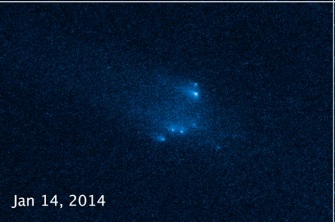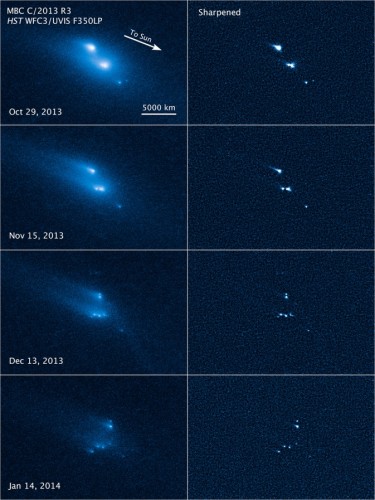The asteroid began to disintegrate early last year, but the new fragments continued to float together in the comet's original orbit as seen in recent images.

Fragile comets, composed mostly of ice and dust, have been observed to disintegrate as they approach the Sun, but nothing like this has ever happened to an object in the asteroid belt.
"This is a rock, and seeing it disintegrate before our eyes is quite amazing," said David Jewitt of the University of California, Los Angeles, who was the researcher of the astronomical "MZP".
The asteroid, designated P/2013 R3, was initially identified as unusual and vaguely shaped when it was discovered by the Catalina and Panstars observatories on September 15, 2013. Follow-up observations on October 1 by the Keck Observatory on Mauna Kea, a dormant volcano on the island of Hawaii, revealed three Bodies move together in a dust envelope with a total diameter similar to that of the Earth.
"The Keck Observatory showed us something that was worth watching at Hubble," said Jewitt. "With its excellent resolution, the space telescope showed in a short time that it is actually ten objects, each of which has a comet-like tail made of dust. The four large rock fragments are up to 400 meters in diameter."
The Hubble data showed that the fragments drift apart at a slow speed of 1.5 km/h. The asteroid began to disintegrate early last year, but the new fragments continued to float together in the comet's original orbit as seen in recent images.
It is unlikely that the asteroid broke up due to a collision with another asteroid, because then it would have been a much more violent process than what we see. Fragments from a collision occurring at high speed are expected to move much faster than the fragments this time. The astronomers also ruled out the possibility that the asteroid disintegrated as a result of internal gas pressure caused by the heating of ice and its evaporation.
The remaining hypothesis is that the asteroid disintegrated due to the cumulative pressure of solar radiation which caused its rotation rate to gradually increase. Finally, the parts that make it up, like grapes on a stem, succumb to the centrifugal force and are pulled apart.
The possibility of disruption in this way has been discussed by scientists for several years, but has never been reliably observed.
For this scenario to play out, P/2013 R3 must consist of several fragments loosely held together by countless non-destructive collisions with other asteroids. It is estimated that most of the small asteroids were badly damaged during the solar system's billions of years. P/2013 R3 is likely a byproduct of such a collision over the past billion years.
This discovery, which is added to another discovery from last year, of A six-tailed asteroid, known as P/2013 P5. Astronomers are therefore finding more evidence that the pressure of sunlight may be a primary factor in the disintegration of small asteroids, which are less than a kilometer in diameter, in our solar system.

The remains of the asteroid weighing about 200 thousand tons may be a rich source of meteorites in the future. Most of them will eventually crash into the sun but a fraction of them may one day cross our sky and produce a nice meteor shower.

One response
Precisely the fact that the asteroid disintegrated in an environment close to the sun increases the possibility that it disintegrated from the evaporation of some ice mixed in it.
good week
Sabdarmish Yehuda